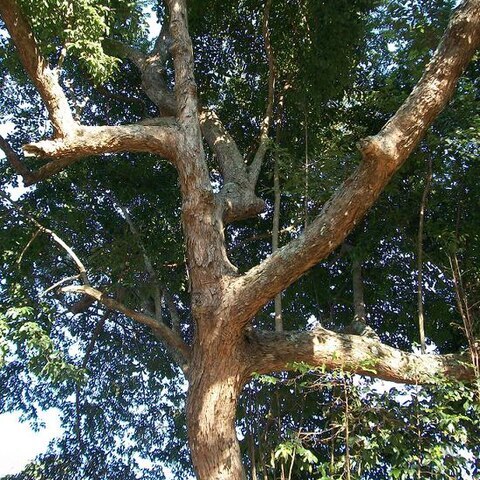Dioecious trees or shrubs with a simple indumentum. Leaves alternate, shortly petiolate, stipulate, simple, entire, penninerved. Flowers axillary, usually in the proximal axils of leafy branches, the males several, fasciculate, the females 2–3 per axil or often solitary. Male flowers: pedicels capillary; calyx-lobes 4, imbricate; petals 0; disc annular, ± entire; stamens 4, free, anthers extrorse, longitudinally dehiscent; pistillode 0. Female flowers: pedicels stouter than in the ♂ flowers; calyx-lobes and disc ± as in the ♂ flowers; ovary smooth, commonly glabrous, (2–)3–4(–5)-locular, with 2 ovules per locule; styles free or united at the base or for 1/2 their length, shortly bifid, rarely bifid. Fruit (2–)3–4(–5)-lobed, irregularly dehiscent or subindehiscent; endocarp paleaceous-crustaceous. Seeds 2 per locule, sometimes 1 by abortion, hemispherical, smooth or rugose, ecarunculate; endosperm copious; embryo ± straight; cotyledons thin, flat, much longer than the radicle.
Seeds 2 per locule, sometimes 1 by abortion, hemispherical, ecarunculate; sarcotesta fleshy, bluish; sclerotesta thick, woody or bony, smooth or rugose, chalaza invaginated; endosperm copious, whitish; embryo ± straight; cotyledons thin, flat, much longer than the radicle.
Female flowers: pedicels stouter than in the male flowers; calyx lobes and disk ± as in the male flowers; ovary smooth, commonly glabrous, (2)3–4(5)-locular, ovules 2 per locule; styles free or variously united, bifid to bipartite.
Male flowers: pedicels capillary; calyx lobes 4, imbricate; petals absent; disk annular, ± entire; stamens 4, filaments free, anthers extrorse, longitudinally dehiscent; pistillode (non-functional ovary) absent.
Flowers axillary, usually in the proximal axils of new shoots; the males usually several, fasciculate, often precocious; the females 2–3 per axil or often solitary.
Fruit (2)3–4(5)-lobed, irregularly dehiscent or subindehiscent; exocarp green, usually separating from the paleaceous-crustaceous endocarp.
Leaves distichous, shortly petiolate, stipulate, simple, entire, penninerved, usually deciduous.
Dioecious, very rarely monoecious, trees or shrubs, rarely scandent.
Indumentum simple.

